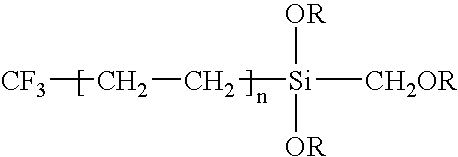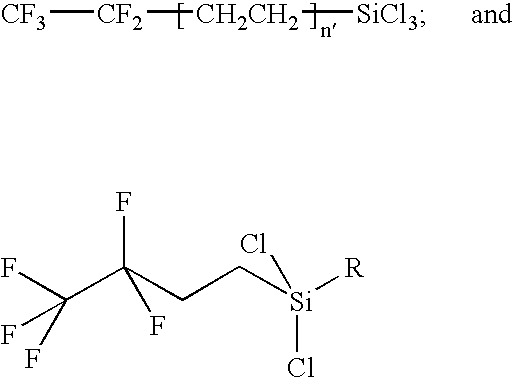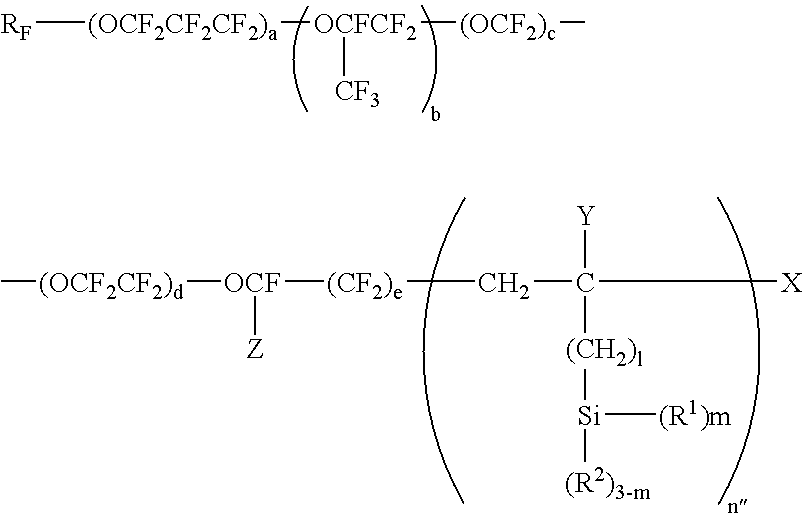Method for Improving the Edging of an Optical Article by Providing a Temporary Layer of an Organic Material
a technology of organic material and optical article, which is applied in the direction of instruments, coatings, applications, etc., can solve the problems of reducing the visual power of the user wearing the eyeglasses, generating much more important stresses, and difficult satisfactory edging operations, so as to prevent the lens from sliding and eliminate the offset effect of the lens
- Summary
- Abstract
- Description
- Claims
- Application Information
AI Technical Summary
Benefits of technology
Problems solved by technology
Method used
Image
Examples
example 1
[0183] Organic glasses were prepared, bearing three anti-abrasion, anti-reflection, hydrophobic / oil-repellent coatings that are coated in said order on the substrate.
[0184] The deposits were achieved on substrates which are polycarbonate ophthalmic lenses comprising, on both sides, an anti-abrasion coating of the polysiloxane type corresponding to example 3 in the Patent Application EP 614957 in the Applicant's name. The treated lenses were round 65 mm diameter lenses. The lenses were washed in an ultra-sound cleaning vessel, steamed for 3 hours minimum at a temperature of 100° C. They were then ready to be treated.
[0185] 1. Preparation of the Lenses
[0186] 1.1 Deposition of the Anti-Reflection and Hydrophobic / oleophobic Coating
[0187] The vacuum treating machine used is a Balzers BAK760 machine provided with an electron gun, an ion gun of the “end-Hall” Mark 2 Commonwealth type and an evaporation source with a Joule effect.
[0188] The lenses were placed on a carrousel provided wi...
example 2
[0210] Piano Orma® lenses coated with anti-reflection and hydrophobic / oleophobic coatings as in example 1, are spin coated (700 rpm during 20 seconds) with the following temporary layer compositions.
Coating composition1H,1H-Pentafluoropropanol-1Lens n°(wt %)110230350
The solvent used is Demnum solvent from Daikin or HFE7100 from 3M
[0211] Water contact angles, hysteresis and surface energy of the temporary layers are determined. Results are given in the table below.
Watercontact angleHysteresisSurface(°)(°)energyLens n°θaθrΔθmJ / m21117.194.622.515.52118.295.822.213.93120.4110.010.013.1
[0212] All measurements have been made four months after obtention of the coated lenses.
[0213] Surface energy has been measured according to Owens-Wendt using two liquids (water and diiodomethane).
Determination of Contact Angles and Hysteresis
Hysteresis Measurements
Material
[0214] Digidrop apparatus, version 4-12 from GBX using the plunging needle mode.
[0215] Syringe: Ref DGD-SP-1 5 from GBX ...
PUM
| Property | Measurement | Unit |
|---|---|---|
| surface energy | aaaaa | aaaaa |
| surface energy | aaaaa | aaaaa |
| water contact angle | aaaaa | aaaaa |
Abstract
Description
Claims
Application Information
 Login to View More
Login to View More - R&D
- Intellectual Property
- Life Sciences
- Materials
- Tech Scout
- Unparalleled Data Quality
- Higher Quality Content
- 60% Fewer Hallucinations
Browse by: Latest US Patents, China's latest patents, Technical Efficacy Thesaurus, Application Domain, Technology Topic, Popular Technical Reports.
© 2025 PatSnap. All rights reserved.Legal|Privacy policy|Modern Slavery Act Transparency Statement|Sitemap|About US| Contact US: help@patsnap.com



